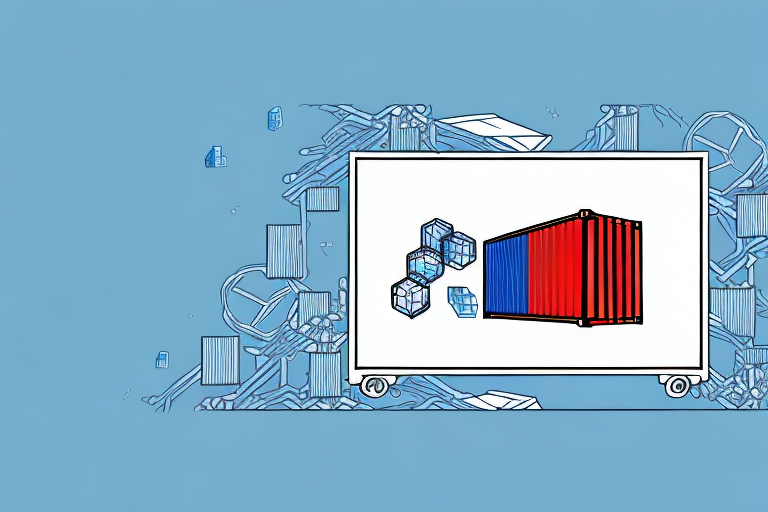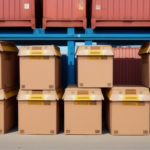Maximizing Efficiency with High Cube (HC) Containers in Your Supply Chain
In today's fast-paced business environment, optimizing supply chain efficiency is crucial. One effective solution that has gained traction is the use of High Cube (HC) containers. These containers offer numerous advantages, including maximizing cargo space and minimizing environmental impact. This article delves into the fundamentals of High Cube containers, their benefits for supply chain management, tips for selecting the appropriate size, and more.
Understanding the Basics of High Cube Containers
A High Cube container is a specialized shipping container taller than standard containers. While a standard container typically stands at 8 feet 6 inches tall, a High Cube container measures approximately 9 feet 6 inches. This increased height provides additional cargo space, making them ideal for businesses seeking to enhance transportation efficiency. Constructed from durable steel, High Cube containers are built to withstand harsh weather conditions and vigorous handling during transit.
Beyond their height, High Cube containers feature reinforced flooring to support heavier loads, making them a preferred choice for transporting heavy machinery and equipment. The extra vertical space facilitates easier loading and unloading, and allows for vertical stacking of goods, thereby maximizing storage capacity.
High Cube containers comply with ISO shipping standards, making them suitable for international shipping. They can be transported via sea, rail, or road and are commonly used for long-distance transportation. Additionally, they serve as secure, weather-resistant storage solutions for goods and equipment.
Benefits of High Cube Containers for Supply Chain Management
- Increased Cargo Capacity: High Cube containers offer more cargo space, allowing businesses to transport more goods per container. This can reduce the number of trips required and lower overall transportation costs.
- Enhanced Durability: Constructed from stronger materials, High Cube containers can endure harsher weather conditions and rough handling, ensuring the safety of transported goods.
- Improved Security Features: Many High Cube containers come equipped with advanced security features such as lockboxes and high-security door locks, minimizing the risk of theft and damage.
- Versatility for Oversized Items: The additional height makes these containers suitable for transporting oversized or bulky items that standard containers cannot accommodate.
Optimizing Cargo Space with High Cube Containers
High Cube containers excel in optimizing cargo space. The extra 1 foot 6 inches in height translates to approximately 155 additional cubic feet of space in a 20-foot container, increasing its volume from around 1,165 to 1,320 cubic feet. This allows for more goods to be transported without incurring additional transportation costs.
The increased height also provides greater flexibility in the types of goods that can be transported. Taller items such as machinery, construction materials, and agricultural products can be easily accommodated, making High Cube containers a versatile solution for various industries.
Enhancing Supply Chain Efficiency with High Cube Containers
Implementing High Cube containers can significantly enhance supply chain efficiency. By transporting more goods per container, businesses can reduce the number of trips needed, saving both time and money. This efficiency not only streamlines operations but also contributes to a lower carbon footprint by minimizing fuel consumption and greenhouse gas emissions.
Additionally, High Cube containers reduce the risk of product damage during transit. The enhanced stacking capabilities prevent cargo from shifting, ensuring that goods arrive at their destination intact.
Customization options further contribute to supply chain efficiency. Businesses can modify High Cube containers with shelves, racks, or climate control systems to better organize and preserve their products during transportation.
Choosing the Right High Cube Container Size for Your Needs
Selecting the appropriate size of High Cube container involves several considerations:
- Dimensions of Goods: Assess the size of the items to be transported to determine the necessary container size.
- Weight of Cargo: Ensure the container can support the weight of your goods without exceeding load limits.
- Regulatory Requirements: Comply with industry-specific regulations that may dictate container specifications.
- Transportation Method: Choose a container size compatible with your chosen mode of transport, whether by sea, rail, or road.
Additionally, consider the volume of your cargo. High Cube containers are particularly beneficial for bulky or oversized items, but it is essential to avoid overloading to prevent safety hazards and product damage.
Loading and Unloading HC Containers Safely and Efficiently
Efficient loading and unloading of High Cube containers require the use of specialized equipment such as cranes and forklifts. Proper techniques and procedures must be followed to ensure safety and prevent cargo damage.
- Weight Distribution: Distribute the weight evenly within the container to maintain balance and prevent shifting during transport.
- Secure Packaging: Use blocking and bracing techniques to stabilize cargo.
- Follow Safety Protocols: Adhere to safety guidelines, including the use of personal protective equipment (PPE) like hard hats and safety glasses.
Ensuring that all equipment is well-maintained and regularly inspected is also crucial for safe and efficient loading and unloading operations.
The Role of HC Containers in International Shipping
High Cube containers play a pivotal role in international shipping, especially for long-distance trade. Their compliance with ISO standards ensures compatibility across various modes of transportation, including sea, rail, and road. This versatility makes them an essential component for businesses involved in global trade, enabling the efficient movement of large volumes of goods across continents.
Environmental Benefits of Using HC Containers in Your Supply Chain
High Cube containers contribute to environmental sustainability in several ways:
- Reduced Fuel Consumption: By transporting more goods per trip, fewer trips are needed, leading to lower fuel usage and reduced greenhouse gas emissions.
- Durable Construction: The long-lasting materials used in High Cube containers decrease the frequency of replacements, minimizing waste.
- Less Packaging Waste: Increased stacking and better protection during transit reduce the need for excessive packaging materials.
Debunking Common Misconceptions About High Cube Containers
There are several misconceptions surrounding High Cube containers:
- Cost: While High Cube containers may have a higher upfront cost compared to standard containers, the additional cargo space can lead to significant cost savings by reducing the number of shipments required.
- Limited Use: Contrary to the belief that they are only suitable for oversized items, High Cube containers are versatile and can transport a wide range of goods efficiently.
Innovations in HC Container Technology to Improve Supply Chain Efficiency
The High Cube container industry is continuously evolving with advancements aimed at enhancing supply chain efficiency:
- Tracking Technology: Real-time monitoring systems provide businesses with precise information about the location and condition of their goods, improving visibility and security.
- Enhanced Insulation and Ventilation: Improved designs protect sensitive cargo from environmental fluctuations, ensuring product integrity during transit.
- Smart Containers: Integration of IoT devices for automated tracking, temperature control, and maintenance alerts.
Real-Life Examples of Companies Successfully Utilizing HC Containers in Their Supply Chains
Several companies have realized substantial benefits by integrating High Cube containers into their supply chains:
- Agriculture Industry: An Australian agriculture firm reduced shipping costs by 40% by switching to High Cube containers, enabling larger shipments per trip.
- Manufacturing Sector: A manufacturing company increased its cargo capacity by 40% per container, leading to improved inventory management and reduced transportation expenses.
These success stories highlight the tangible advantages of adopting High Cube containers in various industries.
Overcoming Common Challenges When Implementing HC Containers in Your Supply Chain
While High Cube containers offer numerous benefits, implementing them can present challenges:
- Selecting the Right Size: Determining the appropriate container size for unconventional cargo dimensions requires careful planning and expertise.
- Securing Cargo: Ensuring that goods are properly secured to prevent damage during transit necessitates robust loading techniques and equipment.
Collaborating with experienced logistics and transportation professionals can help address these challenges effectively, ensuring a smooth integration of High Cube containers into your supply chain.
Future Trends and Developments in High Cube Container Usage for Supply Chain Optimization
The future of High Cube containers in supply chain optimization looks promising, with several emerging trends:
- Advanced Tracking Systems: Enhanced real-time tracking will provide deeper insights into cargo movements and conditions.
- Eco-Friendly Materials: Innovations in sustainable materials will lead to more environmentally friendly container options.
- Automated Loading Solutions: Automation in loading and unloading processes will increase efficiency and reduce labor costs.
Conclusion
High Cube containers present a strategic advantage for businesses aiming to optimize their supply chains. By offering increased cargo space, enhancing transportation efficiency, and contributing to environmental sustainability, these containers can positively impact both operational costs and environmental footprint. Understanding the fundamentals of High Cube containers, selecting the right size, and partnering with knowledgeable logistics professionals are key steps to harnessing their full potential.




















